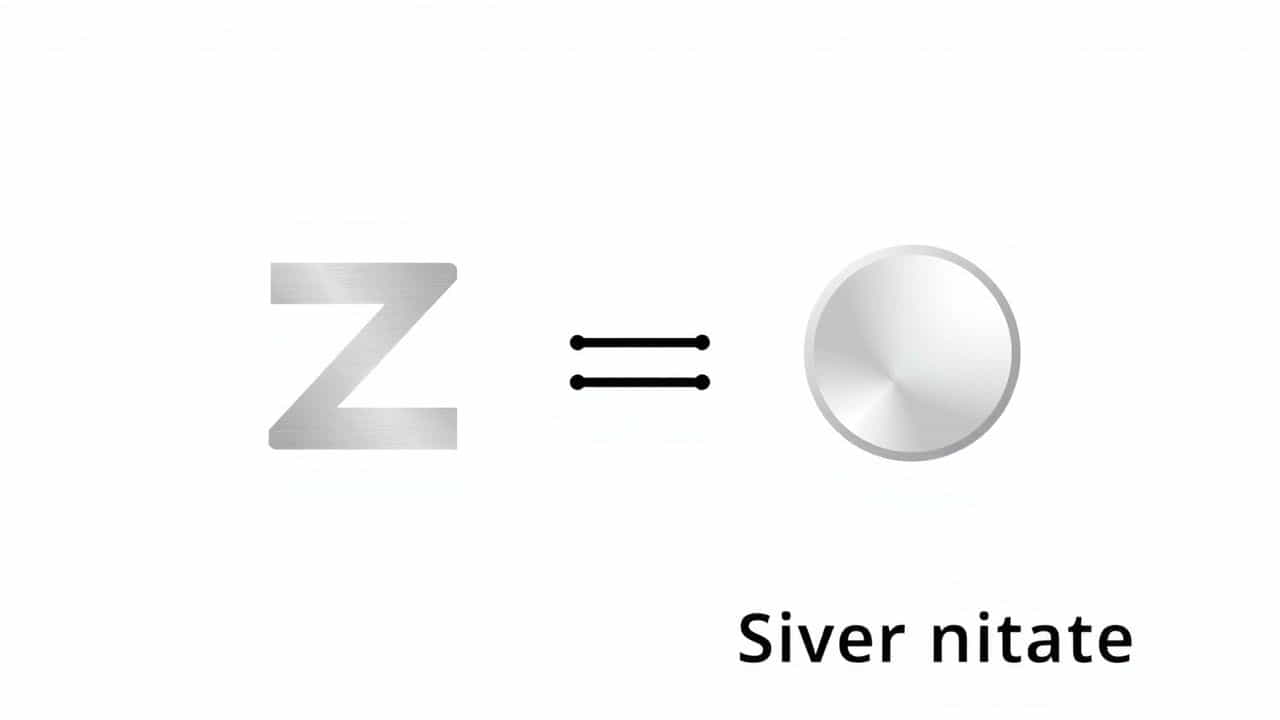When zinc (Zn) reacts with silver nitrate (AgNO₃), a single displacement reaction occurs. In this reaction, zinc displaces silver from silver nitrate, forming zinc nitrate (Zn(NO₃)₂) and metallic silver (Ag).This reaction is commonly used to demonstrate metal displacement, redox reactions, and silver deposition. In this topic, we will explore the chemical equation, reaction mechanism, influencing factors, and practical applications of this reaction.
Understanding the Zn + AgNO₃ Reaction
1. What is Zinc (Zn)?
-
Symbol: Zn
-
Atomic Number: 30
-
Physical State: Solid metal (silvery-gray)
-
Chemical Behavior: Moderately reactive, displaces less reactive metals from solutions
2. What is Silver Nitrate (AgNO₃)?
-
Formula: AgNO₃
-
Type: Ionic compound
-
Dissociation: Fully dissociates in water into Ag⁺ and NO₃⁻ ions
-
Uses: Photography, silver plating, antiseptic applications
3. General Reaction Equation
The balanced molecular equation for this reaction is:
-
Zinc replaces silver because it is more reactive.
-
Zinc nitrate (Zn(NO₃)₂) is soluble and remains in solution.
-
Silver metal (Ag) precipitates as a solid deposit.
Net Ionic Equation of Zn and AgNO₃
1. What is a Net Ionic Equation?
A net ionic equation removes spectator ions and only shows the reacting species in a chemical reaction.
2. Steps to Derive the Net Ionic Equation
Step 1: Write the Full Ionic Equation
Since AgNO₃ is a soluble ionic compound, it dissociates into ions:
Step 2: Remove Spectator Ions
-
Nitrate ions (NO₃⁻) appear on both sides and do not participate in the reaction.
-
Removing them gives the net ionic equation:
This equation shows the core chemical change:
-
Zinc is oxidized to Zn²⁺ (loses electrons).
-
Silver ions (Ag⁺) are reduced to silver metal (Ag).
Reaction Mechanism and Redox Process
1. Oxidation Half-Reaction
Zinc metal loses electrons, forming Zn²⁺ ions:
2. Reduction Half-Reaction
Silver ions gain electrons, forming metallic silver:
3. Overall Redox Reaction
-
Zinc is oxidized (loses electrons).
-
Silver ions are reduced (gain electrons).
-
Zinc acts as the reducing agent, and silver ions act as the oxidizing agent.
Observations During the Reaction
-
Silver metal starts depositing on the surface of zinc.
-
Zinc slowly dissolves in the solution as Zn²⁺ ions.
-
The solution remains clear but may appear slightly cloudy due to silver precipitation.
Factors Affecting the Reaction Rate
1. Concentration of Silver Nitrate
-
A higher AgNO₃ concentration increases the reaction speed.
-
More Ag⁺ ions lead to faster silver deposition.
2. Surface Area of Zinc
- Powdered zinc reacts faster than a solid piece because of greater surface exposure.
3. Temperature
- Higher temperature accelerates the reaction, increasing the rate of silver deposition.
4. Agitation (Stirring)
- Stirring improves ion mobility, making the reaction proceed faster.
Applications of the Zn + AgNO₃ Reaction
1. Silver Extraction and Recovery
- This reaction is used in metallurgy to recover silver from solutions.
2. Silver Plating
- Silver deposition from AgNO₃ solutions is used in coating objects with a thin silver layer.
3. Chemical Demonstrations
- The visual transformation makes it a popular experiment in chemistry education.
4. Photography and Film Processing
- Silver compounds play a crucial role in photographic film development.
Comparison: Zn + AgNO₃ vs. Other Metal-Salt Reactions
| Metal | Reaction with AgNO₃ | Reaction Speed | Products |
|---|---|---|---|
| Zinc (Zn) | Reacts | Medium | Zn(NO₃)₂ + Ag |
| Copper (Cu) | Reacts | Slow | Cu(NO₃)₂ + Ag |
| Iron (Fe) | Reacts | Medium | Fe(NO₃)₂ + Ag |
| Gold (Au) | No reaction | None | No products |
- Zinc and iron react with AgNO₃, but gold does not since it is less reactive than silver.
Safety Considerations When Handling Zn and AgNO₃
1. Handling Silver Nitrate
-
Can stain skin and fabrics due to the formation of silver ptopics.
-
Irritant to eyes and mucous membranes—wear gloves and safety goggles.
2. Handling Zinc
-
Generally safe, but zinc dust can be hazardous if inhaled.
-
Store zinc in dry conditions to prevent oxidation.
3. Proper Disposal
-
Silver nitrate solutions should not be disposed of in regular drains.
-
Collect and recycle silver where possible.
Frequently Asked Questions (FAQs)
1. Why does zinc react with silver nitrate?
Zinc is more reactive than silver, so it displaces silver from the solution, forming zinc nitrate and silver metal.
2. What is the net ionic equation for Zn and AgNO₃?
3. Can copper replace silver in AgNO₃ solution?
Yes, copper is also more reactive than silver and will displace it from silver nitrate.
4. What happens to silver in the reaction?
Silver ions gain electrons and form solid silver metal, which deposits on the zinc surface.
5. What is the color of silver nitrate solution?
Pure AgNO₃ solution is colorless, but it can turn gray or black upon exposure to light.
The reaction between zinc and silver nitrate is a single displacement and redox reaction, where zinc replaces silver from the solution. The net ionic equation simplifies the reaction, showing the essential electron transfer process.
This reaction is widely used in silver recovery, silver plating, and chemical demonstrations. Understanding the reaction mechanism, influencing factors, and applications helps in utilizing it effectively in various scientific and industrial fields.
“
